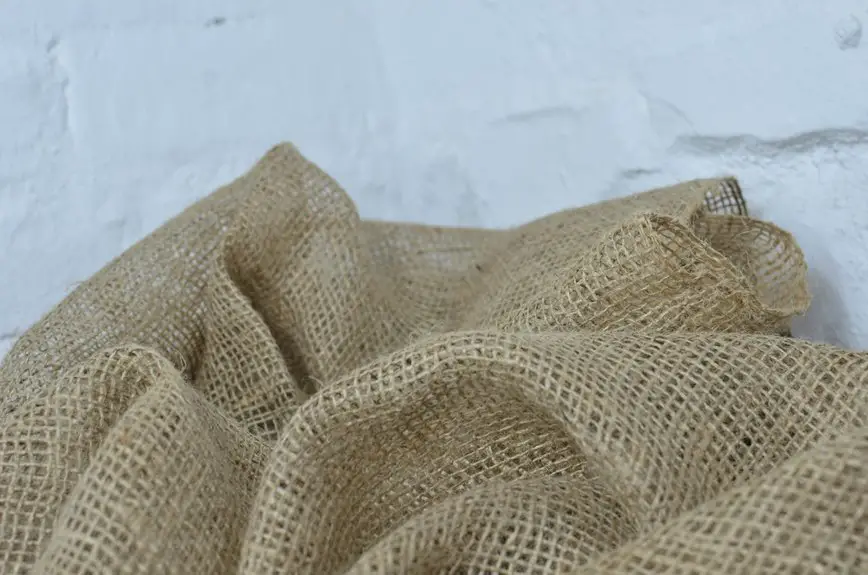You can soften jute fabric by first inspecting and trimming any loose fibers, then soaking it in lukewarm water with mild detergent to remove stiffness. After rinsing thoroughly, soak the fabric in a diluted conditioner or natural softeners like vinegar or baking soda to relax the fibers. Air dry your jute in the shade, and avoid harsh scrubbing to keep it from roughening. Keep going, and you’ll discover even more tips to make jute pleasantly soft for your clothing and craft projects.
Table of Contents
Key Takeaways
- Soak jute fabric in lukewarm water with mild detergent, then rinse thoroughly to remove oils and residues.
- Apply natural softeners like diluted white vinegar or baking soda to relax and soften fibers gently.
- Use commercial fabric softeners or soak in diluted conditioner for 15 minutes to enhance softness and fragrance.
- Air dry jute fabric flat or hang in shaded areas to maintain softness and prevent brittleness.
- Gently brush fabric with a soft-bristled brush after drying to refresh and smooth the texture.
Understanding the Texture of Jute Fabric
Although jute fabric is known for its durability, you might find its rough texture uncomfortable at first. That’s because jute fibers are naturally coarse and stiff, which gives the fabric its strength but can feel abrasive against your skin.
You’ll notice a distinct scratchy quality, especially if you’re used to softer fabrics like cotton or linen. Jute’s texture comes from its long, shiny fibers that are tightly woven, making it less flexible initially.
When you handle jute, expect it to feel rigid and a bit inflexible. Understanding this texture helps you set realistic expectations and guides you in choosing the right methods to soften it effectively for clothing or crafts.
Recognizing the fabric’s natural roughness is the first step toward making it more comfortable.
Pre-Treatment Techniques to Prepare Jute
Before you start softening jute fabric, you’ll want to prepare it properly with some pre-treatment techniques. First, inspect the fabric for any loose fibers or knots and gently trim them to avoid uneven softening.
Next, consider lightly steaming the fabric to relax the stiff fibers without saturating it. If you’re dealing with new jute, it often contains natural oils and sizing agents that make it stiff. To remove these, soak the fabric briefly in lukewarm water mixed with a mild detergent, then rinse thoroughly.
Avoid harsh chemicals that can damage the fibers. Finally, let the fabric air dry completely before moving on. These steps guarantee your jute is clean, flexible, and ready for effective softening in the next stages.
Washing and Conditioning Methods for Softening
Once you’ve prepared your jute fabric, washing it gently with a mild detergent helps remove remaining stiffness while conditioning restores softness and flexibility.
Use lukewarm water to prevent shrinking or damage, and avoid harsh scrubbing that might roughen the fibers. After washing, rinse thoroughly to eliminate detergent residue, which can cause stiffness.
For conditioning, soak the fabric in a diluted conditioner or a fabric-friendly softener for about 15 minutes. Then, rinse gently to keep the softness intact.
Avoid wringing the jute to prevent distortion; instead, press out excess water carefully. Finally, air-dry the fabric flat or hang it in a shaded area to maintain its texture and avoid brittleness.
Following these steps guarantees your jute becomes comfortably pliable for clothing or crafts.
Using Natural Softeners and Fabric Softeners
After washing and conditioning your jute fabric, you can enhance its softness further by using natural softeners or commercial fabric softeners. Natural softeners like vinegar or baking soda gently relax fibers without harsh chemicals, while commercial options offer convenience and added fragrance. Choose based on your preference and project needs.
| Softener Type | Benefits |
|---|---|
| White Vinegar | Softens fibers, eco-friendly |
| Baking Soda | Neutralizes odor, mild softening |
| Commercial Softener | Quick softening, pleasant scent |
| Coconut Oil | Natural conditioning |
| Aloe Vera Juice | Adds moisture, gentle on fabric |
Mix natural softeners in rinse water, or follow instructions for commercial products to avoid residue buildup.
Tips for Maintaining Softness in Jute Projects
Although jute naturally stiffens over time, you can keep your projects feeling soft by handling them with care and following simple maintenance routines.
Avoid excessive exposure to direct sunlight, which can dry out fibers and make them brittle. When cleaning, use mild detergents and avoid harsh chemicals that break down jute’s natural softness.
Always air dry your jute items flat in a shaded area to prevent stiffening. To refresh softness, gently brush the fabric with a soft-bristled brush or rub it between your hands.
Store jute pieces in breathable bags to avoid moisture buildup, which can lead to stiffness or mildew.
Frequently Asked Questions
Can Jute Fabric Be Dyed Without Losing Softness?
You can dye jute fabric without losing softness by using gentle, fiber-reactive dyes and avoiding harsh chemicals. Always pre-soften the fabric and rinse thoroughly to maintain its natural texture and flexibility after dyeing.
Is Jute Fabric Hypoallergenic for Sensitive Skin?
If your skin tends to throw little protests, jute might whisper a gentle challenge instead of a full shout. It’s naturally coarse, so while not truly hypoallergenic, you might want to test it carefully first.
What Is the Environmental Impact of Jute Production?
You’ll find jute production eco-friendly since it uses less water and pesticides than cotton. It also improves soil fertility and is biodegradable, making it a sustainable choice that reduces your environmental footprint considerably.
How Durable Is Softened Jute Compared to Untreated Jute?
You’ll find softened jute is slightly less durable than untreated jute because the softening process weakens some fibers. However, it remains sturdy enough for most clothing and craft uses, balancing comfort with strength effectively.
Can Softened Jute Fabric Be Used for Upholstery?
Imagine a sturdy ship softened by gentle waves; softened jute can brave upholstery’s seas, but it won’t match untreated jute’s toughness. You’ll want extra protection to keep it looking shipshape and comfy.
- All About 37.5 Coconut Fabric Technology in Performance Wear - June 29, 2025
- Can You Use Coconut Oil to Remove Acrylic Paint From Fabric? - June 29, 2025
- The Ultimate Guide to Coconut-Themed Fabric Patterns - June 29, 2025






